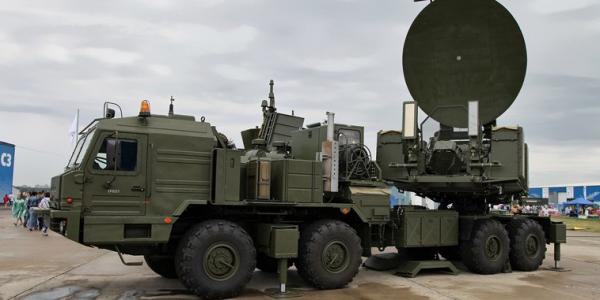Russian Electronic Warfare Targets NATO Assets
Russia has advanced the state of the art in electronic warfare capabilities to overcome and even overpower Western electronic systems, both military and commercial. And now the country’s military modernization plan extending to 2025 lays the groundwork for further advancement, according to a recent European think tank report.
Russia is developing a total package of electronic warfare (EW) systems covering a broad frequency range. The systems encompass traditional areas such as surveillance, protection and countermeasures, and they shield Russian use of the electromagnetic spectrum (EMS). These total package systems are designed to be highly mobile and include small units deployable by unmanned aerial vehicles (UAVs).
Russian EW will be able to jam, disrupt and interfere with NATO communications, UAVs, radar and other sensor systems, the report posits. NATO’s plans to defend its Baltic members and others along Europe’s eastern flank could be disrupted by a Russian EW assault as part of an anti-access/area denial (A2/AD) campaign targeting alliance communications and information systems.
The report, issued by Roger N. McDermott of the International Center for Defense and Security in Estonia and supported by a research grant from the Estonian Defense Ministry, focuses on Russian EW concerns in the Baltic region. But the report’s findings also could apply to Russian forces adjacent to NATO borders because these EW capabilities are mobile.
The improvements to Russian EW are complemented by changes in Russian force organization, doctrine, command structure, training, and tactics, techniques and procedures. These changes extend well beyond air defense and A2/AD to include cyber and psychological operations. The report predicts a growing convergence of EW, cyber and information warfare in Russian forces, a trend already underway in the West.
Despite its harsh depictions of Russian EW capability, the report warns against exaggerating how badly this capability could cripple NATO systems. In particular, the report seeks to debunk the claim that Russian forces in 2014 blinded an Aegis ballistic missile defense system aboard a U.S. Navy warship in the Black Sea. The report attributes this story, which it describes as “fake news,” to Russian state newspaper accounts supported by other government commemorative actions, and it notes that the Atlantic Council’s Digital Forensic Research Lab thoroughly debunked the story and its related aftermath this spring.
Nonetheless, Russia’s multiyear plan to invest billions of rubles in EW shows no signs of abating. This strategy predates the Ukraine conflict, but lessons learned there have influenced planning as well as EW research and development.
Russian military leaders have described the national strategic EW system in development as an asymmetric response to the network-centric system of combat operations that NATO conducts. The Russian system includes the Murmansk-BN, a jammer with a reported range of 5,000 kilometers (about 3,100 miles) deployed on seven trucks. It monitors activity on airwaves and has a broad jamming capability. Russians say the Murmansk-BN targets the U.S. High Frequency Global Communications System, which forms the backbone of command and control (C2) for U.S. and NATO ships and aircraft.
Another component of Russian EW being developed is the RB-109A Bylina, which will be designed for automated C2 of EW systems at the brigade level. It will include artificial intelligence to analyze the EMS and prioritize targets in real time. Scheduled to begin fielding next year, the system could be available to Russian forces by 2025.
Other Russian automated EW systems aim to disrupt early warning radars, air defense missile systems and UAVs at ranges of tens of kilometers. Some use advanced targeting procedures to neutralize or destroy Western C2 systems.
Ukraine, in particular Crimea, proved an excellent testing ground for Russian EW. Russian specialists employing EW severed C2 among Ukrainian military bases as part of the process of conquering the peninsula. When Russian forces moved into Donbass, they brought many EW systems and trained local separatist forces to use them. The report states that much of the Russian EW activity in Donbass was clandestine and difficult to assess, as it seemed to involve highly mobile units. Some Russian units there experimented with new EW algorithms.
Still, Ukrainian forces learned to operate in a hostile EW environment. They had received limited training from Western militaries and possessed some Single Channel Ground and Airborne Radio System (SINCGARS) units. Among the lessons they learned was that Russian forces had devised methods of deploying independent tactical EW groups that could operate on the move, the report says. It also seemed that Russian leadership had assigned high priority to testing new EW tactics, including targeting artillery fire with complementary EW to facilitate psychological operations.
For NATO, these experiences demonstrate that the first sign of Russian military activity against eastern European members will be in the EMS, the report states. The alliance has a lot to do to rectify the neglect of Russia’s emergence as a competitor there. With the Russian military dedicated to strengthening EW to achieve an advantage over Western forces, “NATO must change its approaches to policy, doctrine, organization, capabilities, training, tactics and procedures and exercise scenarios,” the report declares.





Comment
To think that there's even
To think that there's even the remotest possibility that Russia has an interest in regaining the Baltic States by force is a storyline right out of Dr. Strangelove. Sorry, but as far as the Baltic States and NATO go, it's the former pulling the latter by the nose ring and the latter using the former as a convenient staging area to justify its expansionism. A true display of nonproductive symbiosis. Whataboutism, you say? What about Ukraine? What about it indeed:
NATO had its heart and soul set on control of Crimea. Everyone not comatose recognizes that at this stage. Its supporters thought a coup d'etat would clinch the deal and damn the consequences. The best laid plans of mice and men. Atlantic Council? You decide which species applies.
Comments